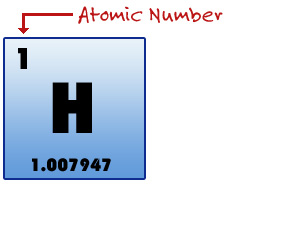 |
Look very carefully at the boxes in the periodic table. Notice that no matter what form of the table you are using, there are always three very specific items that appear for each element. First, there is an integer (whole number) in some part of the box. This is the atomic number of the element. It represents the number of protons found in the nucleus of one atom of that particular element. See how the atomic number increases by one for each box as you move across the table in a period? This means that each element has its own special number of protons in each atom. For example, every atom of hydrogen has one proton in its nucleus -- always. Every atom of helium has two protons in its nucleus. Every atom of lithium contains three protons in its nucleus. This is very important to know, because it is the number of protons in the nucleus that determines what element you are working with. If you add a proton to a carbon atom, you will not have carbon anymore -- it will be nitrogen! If you take a proton away from a calcium atom, it will not be calcium anymore. The new atom is an atom of potassium instead. The elements change as you move across the table from block to block, left to right, because you are changing the number of protons in each new block.
|
 |

 |
